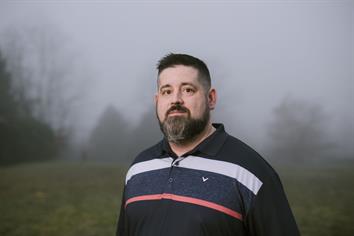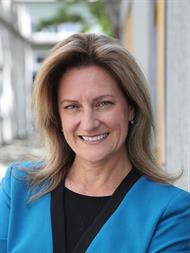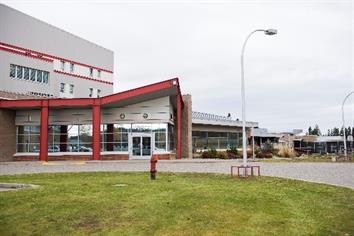The creation and implementation of Indigenous Patient Navigator roles across PHSA, including at BC Cancer, BC Children’s Hospital and BC Women’s Hospital and Health Centre, came in response to the 2020 "In Plain Sight" report, where evidence of systemic and widespread Indigenous-specific racism within the B.C. health system was identified. Although this information has long been known by Indigenous Peoples, this report further amplified the need for concrete actions be taken that address Indigenous-specific racism, Indigenous cultural safety and humility education, and a systems change approach.

Chris Tyler has been a member of the inter-disciplinary team at Prince George Regional Correctional Centre for nearly a year, walking alongside Indigenous clients as they navigate the health services at the centre and upon discharge back into their communities.
“Indigenous people have trouble trusting the health care system, which has systemically discriminated against their communities for years,” he said. “In this role, I am working to build up our clients’ trust as well as to help them understand what the doctors and care teams are telling them. I am a connector between the two.”
“There is a risk that people, particularly those with mental health or substance use issues, can fall through the cracks when they come into contact with the justice system."

“When we think about clients in corrections, we have to think about the bigger picture,” said Nancy Desrosiers, the provincial executive director at CHS. “There is a risk that people, particularly those with mental health or substance use issues, can fall through the cracks when they come into contact with the justice system. Ensuring patient-centred care and continuity of care for all clients, whether Indigenous or not, is a priority for us. For our Indigenous clients, providing a support system by way of an Indigenous patient navigator is an important step to being able to continually provide culturally humble and safe care.”
For continuity of care, the scope of what and Indigenous patient navigator can do needs to extend beyond the walls of the prison centre.
“I assist with community transitions, connecting people with community health representatives when they leave here,” Tyler explains. “This helps clients settle into the community and continue to stay well. Recently, I had a client waiting for an ultrasound. Ordinarily, the hospital would contact him on his cell, but he didn’t have access to it while he was incarcerated. I got the transfer information from the hospital so that if he was released before his appointment date, I could transfer management to his community health representative so nothing would be missed. We made sure his health and wellbeing did not get lost in the transfer.”
This is just one example of the work of an Indigenous patient navigator. Tyler is also able to attend health appointments when requested and can review health records with clients to ensure that they feel informed and included in their health care journey. This has empowered individuals to be active in their health care and has improved clients’ understanding of their diagnoses and treatment plans.
Tyler recalls many rewarding and memorable moments, such as helping clients navigate
First Nations Health Authority for vision care and obtaining prescription glasses. While this may seem small, it created a massive difference in the quality of life for the clients.
“There are so many cultural programs available—beadwork, dream-catcher and moccasin making, reading and educational programs,” he said. “If you can’t see very well, or get headaches from eye-strain, it demotivates you and makes participation difficult. Clients have told me that getting glasses was a major turning point in their lives here.”
Indigenous patient navigators and Indigenous care coordinators are there not only to support clients but also colleagues. Tyler encourages health care professionals to lean into the resources that are available through these roles. “If you have an Indigenous patient navigator on your team or in your centre, use them, talk to them. They can help in so many ways,” he said. “I sit with health services managers, nurses and other health professionals every day and we work together to bring a better understanding of our client needs and how we can meet these needs.”
Tyler explains there is still a ways to go in addressing the gap in health care available to Indigenous and non-Indigenous people.
"I want people to first acknowledge that racism within healthcare system exists. For us to make meaningful change, we need to first agree there is a problem."

“I want people to first acknowledge that racism within the healthcare system exists,” he said. “For us to make meaningful change, we need to first agree there is a problem. We are working with people and these people have needs. For Indigenous clients, these needs relate to our nation’s history of oppression, which cannot be ignored any longer.”
Indigenous Peoples represent roughly 5.9% of the total adult population across British Columbia. However, in
BC Corrections, Indigenous Peoples account for 35% of admissions, an alarming and overwhelming statistic that showcases the continued systemic racism in the justice system. In order to move towards meaningful reconciliation, the
Truth and Reconciliation Calls to Action 25-40 need to be implemented. These Calls to Action include responding to underlying causes of offending, creation of additional Aboriginal healing lodges within federal correctional systems and governments to work with Aboriginal communities to provide culturally relevant services to individuals on issues related to substance abuse, family and domestic violence and overcoming experiences of sexual abuse. While there is much work to do, BC Mental Health and Substance Use Services is taking a step forward in this with the first permanent position of Indigenous patient navigator at the Prince George facility with hopes of additional positions in the future.
Prince George Regional Correctional Centre has begun the process of incorporating the Dakelh language in the health centre. Working alongside the
Lheidli T’enneh First Nation and linguistics experts to create culturally-appropriate signage that will be placed in treatment rooms as well as the ts’unduda neghunli bayoh, or nursing station. This is an important step in creating safe and welcoming spaces for Indigenous clients accessing services.
